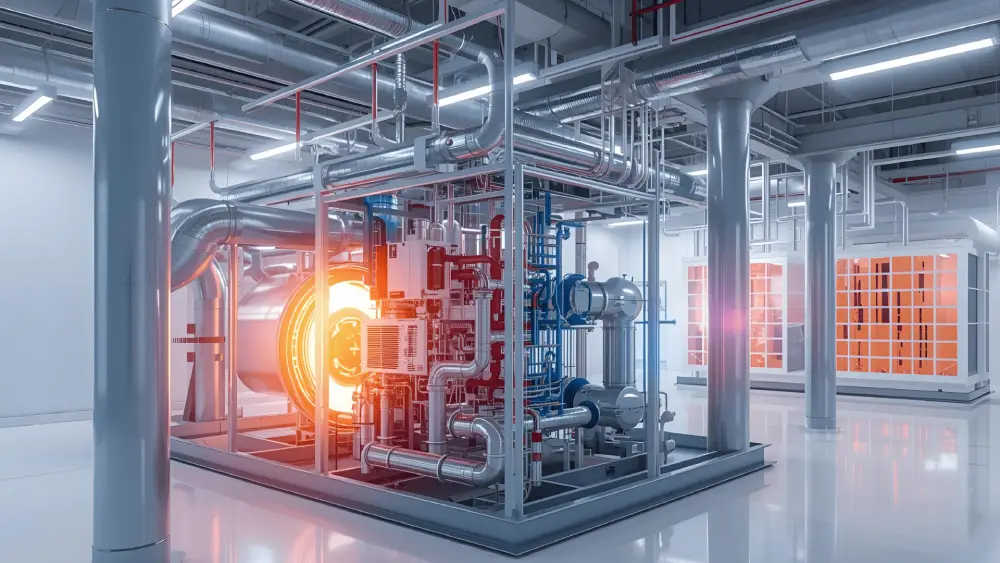As we move deeper into 2025, commercial building owners and facility managers are placing greater emphasis on energy efficiency, sustainability, and occupant comfort. These priorities are driving innovation in heating, ventilation, and air conditioning (HVAC) design. From AI-powered systems to advanced refrigerants, the HVAC landscape is evolving to meet both environmental regulations and modern comfort demands.
Let’s explore the top Mechanical HVAC design trends that are shaping the future of commercial buildings in 2025.
1. Smart and AI-Driven HVAC Systems
Artificial Intelligence (AI) and the Internet of Things (IoT) are revolutionizing HVAC design. Today’s smart systems can collect real-time data on occupancy levels, weather patterns, and energy usage, automatically adjusting settings to optimize comfort and reduce waste.
Modern AI-driven HVAC systems:
- Predict maintenance needs before breakdowns occur
- Adjust airflow and temperature dynamically across zones
- Integrate with Building Management Systems (BMS) for seamless control
This level of automation not only improves energy performance but also extends the lifespan of HVAC equipment.
2. Focus on Energy Efficiency and Net-Zero Goals
The global push toward net-zero buildings is influencing Mechanical HVAC design in a big way. In 2025, more commercial properties are using high-efficiency heat pumps, energy recovery ventilators (ERVs), and variable refrigerant flow (VRF) systems to minimize energy use.
Key approaches include:
- Geothermal systems that use the earth’s constant temperature for heating and cooling
- Demand-controlled ventilation (DCV) that adjusts airflow based on CO₂ levels
- High-performance insulation and glazing to reduce thermal load
Energy codes like ASHRAE 90.1 and green certifications such as LEED and WELL are setting new benchmarks for performance, motivating engineers to design HVAC systems that meet or exceed these standards.
3. Electrification and Alternative Energy Integration
Electrification continues to dominate the Mechanical HVAC conversation. By replacing fossil fuel–based heating systems with electric heat pumps, building owners can significantly reduce carbon emissions and improve efficiency.
In 2025, we’re seeing a growing integration of Mechanical HVAC systems with renewable energy sources such as:
- Solar-assisted HVAC for powering compressors and ventilation fans
- Thermal energy storage to shift cooling loads to off-peak hours
- Battery-backed systems that ensure uninterrupted operation during outages
This trend aligns with corporate sustainability initiatives and local government mandates pushing for decarbonized infrastructure.
4. Improved Indoor Air Quality (IAQ) Solutions
Post-pandemic building standards have permanently shifted focus toward healthier indoor environments. Mechanical HVAC design now incorporates advanced air filtration, UV-C disinfection, and active air purification technologies.
In 2025, IAQ systems are:
- Using HEPA and MERV 13+ filters to capture fine particles and allergens
- Employing bipolar ionization and UV-C lighting to neutralize pathogens
- Integrating real-time air quality sensors that track and display air metrics
These advancements not only safeguard occupant health but also enhance productivity and satisfaction in commercial spaces.
5. Modular and Prefabricated HVAC Components
Modular Mechanical HVAC design is gaining traction as developers look to reduce installation time and minimize construction disruptions. Prefabricated ductwork, packaged rooftop units, and plug-and-play chillers are simplifying installation while maintaining high precision.
Benefits of modular HVAC systems:
- Reduced on-site labor and waste
- Faster project timelines
- Easier maintenance and scalability
Prefabrication also ensures better quality control and consistency—essential for large-scale commercial projects.
6. Low-GWP Refrigerants and Regulatory Compliance
With global environmental policies tightening, the Mechanical HVAC industry is transitioning away from high–global warming potential (GWP) refrigerants. 2025 marks a significant move toward refrigerants like R-32, R-454B, and R-1234yf, which offer comparable performance with reduced environmental impact.
Engineers and contractors must now balance:
- System efficiency
- Safety considerations (flammability ratings)
- Compliance with EPA and international F-Gas regulations
This shift is reshaping the design and selection process for commercial HVAC systems.
7. Data-Driven Predictive Maintenance
Downtime in commercial buildings can be costly. Predictive maintenance—powered by AI and IoT sensors—helps anticipate issues before they escalate. Sensors continuously monitor metrics such as vibration, pressure, and temperature to detect inefficiencies early.
Facility managers benefit from:
- Reduced emergency repair costs
- Improved equipment longevity
- Real-time performance dashboards
By using data analytics, businesses can move from reactive to proactive maintenance, optimizing operational reliability.
8. Human-Centered HVAC Design
Modern HVAC isn’t just about temperature control—it’s about enhancing occupant well-being. Human-centric design considers how air quality, lighting, humidity, and noise interact to influence comfort and productivity.
In 2025, expect more systems to:
- Use zoned comfort controls that allow individual adjustment
- Maintain optimal humidity (40–60%) for comfort and health
- Incorporate acoustic dampening materials to reduce system noise
This approach bridges the gap between building performance and user satisfaction.
Conclusion
The Mechanical HVAC design trends of 2025 reflect a clear evolution toward smarter, cleaner, and more occupant-focused systems. As commercial buildings adapt to new energy standards and health expectations, innovation will continue to reshape the industry.
Whether it’s integrating AI-driven controls, adopting low-GWP refrigerants, or improving air quality, the future of Mechanical HVAC design is rooted in efficiency, sustainability, and human comfort.

